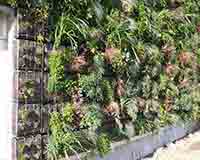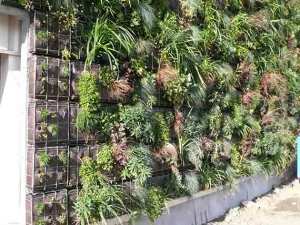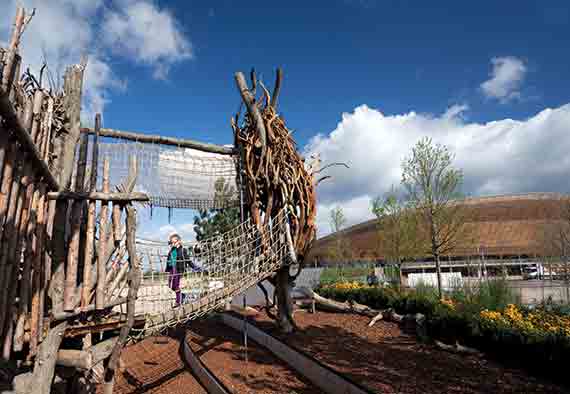With increasing pressure in the working world to design areas promoting health and happiness, how is business benefiting?
Real estate’s role in health and well-being is becoming more and more apparent. Think-tanks are starting to put pressure on government to ensure that our high streets are healthy and not full of fast-food joints and betting shops. And the rise of the millennials through the working ranks is forcing businesses to think more about designing the built environment for health and happiness.
Next week sees the return of Green Sky Thinking, a series of events hosted by leading industry organisations to showcase steps being taken to create more sustainable cities. Here, two design experts share their thoughts on building for health.
 Oliver Heath, founder, Oliver Heath Design
Oliver Heath, founder, Oliver Heath Design
As a designer passionate about the built environment and sustainability, incorporating a sense of nature has been a recurring theme to much of my work. These ideas are neatly summed up under the concept of biophilic design. Biophilia literally means “love of nature” and is a term popularised by the American biologist Edward Wilson when he noted society’s drift away from nature. The term refers to the innate human attraction to nature and natural processes, and concerns our residual genetic inheritance from the hundreds of thousands of years we spent surviving and thriving in nature.
It is only in the past 200 years, since the industrial revolution, as we have become more urbanised, that we have lost our connection to nature, to the detriment of our health and well-being.
Biophilic design looks at how we can use the concepts behind our attraction to nature and natural processes to improve the products we use and spaces that we live and work in every day. As an emerging style it is a subject that is of increasing importance to a number of organisations at the forefront of design in the workplace.
Studies have demonstrated measurable benefits accruing from building types employing biophilic principles. For example, staff working in biophilic offices often have a 15% higher level of self-reported well-being, and can be 6% more productive and 15% more creative.
In fact, companies such as Apple, Amazon and Google are now using biophilic principles to attract and retain the best staff. Biophilic hospitals are associated with improved rates of post-operative recovery with less pain, 8.5% shorter stays and 22% less medication. They allow for improved conditions for staff and visitors, too.
And schools have demonstrated that children learn 20-25% faster when natural light is present, as evidenced by improved test scores of between 10% and 14%, and reduced instances of ADHD.
Biophilic designs create more productive, creative spaces in which people feel healthier and are more engaged.
But it is also at the forefront of sustainable design, helping us to understand that our psychological and physiological well-being is connected intricately to that of nature and the environment.
Key prinicples of biophilic design
Natural light – maximising natural light is essential to our health and well-being, be it through windows, roof lights or glass doors. It helps to govern our circadian rhythms and daily wake/sleep cycles.
Views out onto nature – be it a view onto a park, garden, a green roof space or terrace, views onto nature can improve focus and create a greater sense of calm.
Natural materials – studies have shown that natural materials, patterns, products and textures have a calming and restorative quality with a surprising number of positive side effects. Material such as Interface’s Human Nature collection mimic nature to deliver tangible human benefits.
Safe spaces to retreat back into – we all need a space to sit and restore our energy and focus after a period of activity. Recuperative areas could simply be a quiet space in an office with a view of trees or plants.
 Adrian Wikeley, director of landscape architecture and head of design, LUC Consultants
Adrian Wikeley, director of landscape architecture and head of design, LUC Consultants
Our cities face an uncertain future. More liveable, sustainable cities cannot be achieved without recognising the vital role of the natural environment and its fundamental impact on economic prosperity, health and well-being. Research now presents clear evidence that our urban parks, avenues and woodlands – the green infrastructure of cities – have huge environmental impacts, such as mitigating the negative effects of climate change, and offer a wide range of social and economic benefits.
Today London’s population is 8.5m and it is expected to reach 11.5m in 2050. We need to act now to address this challenge.
As an environmental consultancy LUC has been pioneering ways of adapting our public spaces to the detrimental effects of climate change and providing more integrated design solutions for everything from urban greening to children’s play areas. The design of innovative children’s play facilities is an important area because there is a crisis in our national lifestyle. Headline statistics for obesity and its cost to the NHS and our quality of life are shocking. Habits form during youth and our overprotective urban environments equate to confinement indoors for many young people. This is possibly the most dangerous thing we can do to our children because of its impact on their health and development.
At the new Tumbling Bay playground at London’s Olympic Park, E15, we have created a play, leisure and learning experience comprising an expansive, richly planted playscape that delivers innovative and challenging play experiences for all ages. The play is inspired by ecological processes that link into the surrounding riverine environment. The undulating, complex landscape also contains a café and multifunctional community hub.
The scheme has brought people into the park in advance of the development of the surrounding neighbourhoods, providing future local residents,
along with national and international visitors, with a well-loved, exciting place to play.
Find out more about Green Sky Thinking at www.greenskythinking.org.uk













